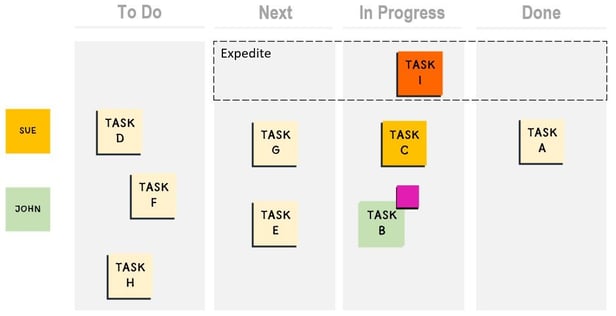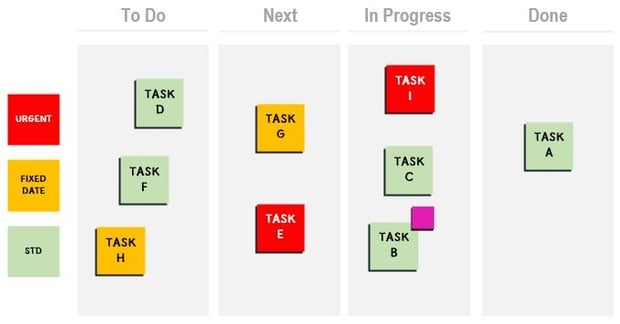Let's assume Task B was blocked so John could work on the urgent Task I. But after that there are choices each team can define as working rules. For example:
Should Sue also block Task C and help with Task I?
As a team you can have a rule about if an Urgent work item means the whole team drops tools and works on it, or if the most suitable person does that, or if all people finish what they have started and then all pile in.
It depends on your context. In IT a Priority 1 Outage (a clear Urgent work item) usually means everyone who can help in the resolution drops other work until the P1 is resolved.
If Sue can't help on Task I she should probably move onto Task E.
Once both Urgent tasks are completed, the due date for the Fixed date item should be checked. If they can't finish the two in progress standard tasks first and meet that date, then the Fixed Date item must take priority.
To summarise: work on Urgent tasks first, then Fixed Date, and then Standard.
These work types don't just govern how work is treated on the board. They can also be used to prioritise work when moving it from the To Do list (although Urgent work items usually just go straight onto the board). Generally you would pull Fixed Date items onto the board early enough to meet their date, and then make up the rest of the Next column with Standard work items.
Be very careful with Urgent and Fixed Date items. Because FIFO is the best path on average, treating some work as special will result in higher average delivery times (you are stealing effort from in-progress work items to deliver other work items faster).
For this reason, most teams only allow 1 Urgent work item at a time, and will also aim to have a fixed percentage of Fixed Date work items (10-20%). The Standard work items are a pressure valve for the system and generally have a lower SLA expectation. Simply apply FIFO to standard work.
Don't let a project manager turn the Kanban board into a Post-it Note Gantt Chart where all the items have fixed delivery dates. This actually won't be as efficient as using the rules we've just discussed.


